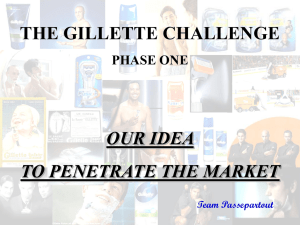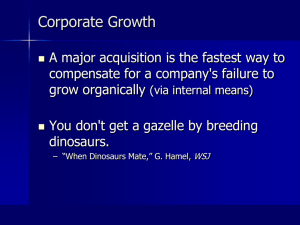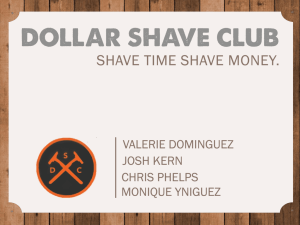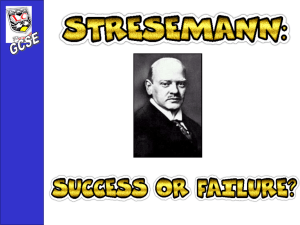Training & Conditioning for Optimal Canine
advertisement
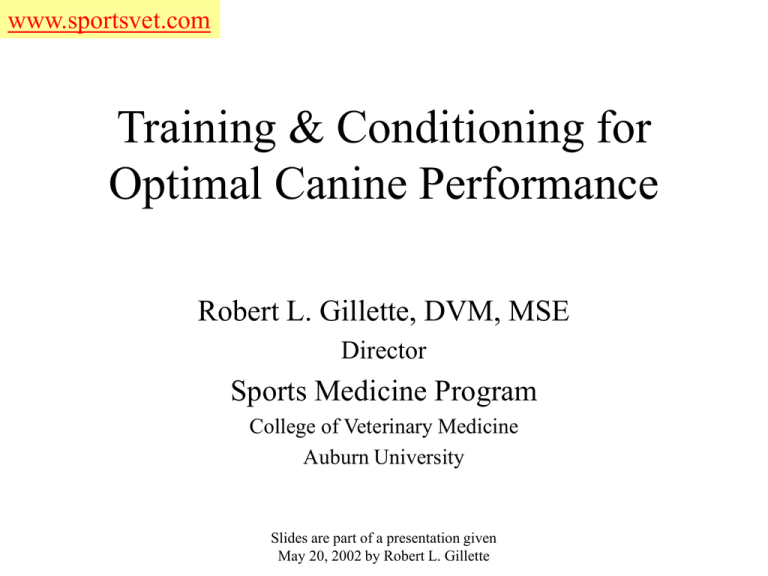
www.sportsvet.com Training & Conditioning for Optimal Canine Performance Robert L. Gillette, DVM, MSE Director Sports Medicine Program College of Veterinary Medicine Auburn University Slides are part of a presentation given May 20, 2002 by Robert L. Gillette www.sportsvet.com It’s The Little Things That Make A Difference! • Canine performance made up of multiple interactions of the body’s various components. • If one of the components malfunctions, the performance as a whole is disrupted. • The level of this disruption is determined by the level of performance needed. Slides are part of a presentation given May 20, 2002 by Robert L. Gillette www.sportsvet.com Performance Physiology The winning dog is the one that produces and maintains the highest energy output for the length of the performance event. Slides are part of a presentation given May 20, 2002 by Robert L. Gillette www.sportsvet.com Performance Overview Positive Forces The Goal Goal Prevention Maximize Positives Minimize Negatives Optimum Performance Distractive Positive Forces Negative Distractive Positive Forces Negative Slides are part of a presentation given May 20, 2002 by Robert L. Gillette www.sportsvet.com Performance Conditioning Training Nutrition Optimum Performance Injury Types Injury Prevention Slides are part of a presentation given May 20, 2002 by Robert L. Gillette www.sportsvet.com Performance Basics • • • • • Demands of performance Dog’s actual ability to perform Handlers expectations of performance Personal performance Comparative performance Slides are part of a presentation given May 20, 2002 by Robert L. Gillette www.sportsvet.com Performance Potential • A dog’s athletic potential for an event or task, is based upon the amount of inherited potential with which it was born. • Our management program should be designed to allow the dog to perform at its maximum potential. • The performance expectations should not exceed the dog’s abilities. Slides are part of a presentation given May 20, 2002 by Robert L. Gillette www.sportsvet.com Canine Performance Potential 100 90 80 Percentage 70 60 50 40 30 20 10 0 Companion Active Working Slides are part of a presentation given May 20, 2002 by Robert L. Gillette Competitive www.sportsvet.com Comparative Performance Low Ability (unused) Medium Potential Level Ability (used) Slides are part of a presentation given May 20, 2002 by Robert L. Gillette High www.sportsvet.com General Comments on Canine Performance • Overall Mindset – Understand the athleticism of the dog – Understand the fine intricacies of the athlete • The whole body is involved in performance • Know the factors that influence ability • Understand the factors that impede ability Slides are part of a presentation given May 20, 2002 by Robert L. Gillette www.sportsvet.com Body system functions that support primary function. •Muscular - Propulsion & Navigation •Skeletal - Support & Structure •Nervous - Stimulation & Balance •Cardiovascular - Cellular Energy & Waste •Respiratory - O2 & CO2; Thermoregulation •GI - Energy Production & Waste Removal •Renal - Fluid Balance & Waste Removal •Hormonal - Maintains Metabolic Balance •Skin - Provides Protective Covering Slides are part of a presentation given May 20, 2002 by Robert L. Gillette www.sportsvet.com Optimizing Canine Performance Factors that Affect Performance Internal Factors • Anatomical • Physiological • Psychological External Factors • Environment • Dog interaction • Handler • Functional Demands • Design and Boundaries of Event Slides are part of a presentation given May 20, 2002 by Robert L. Gillette www.sportsvet.com Canine Performance Impediments Fatigue Pain Conditioning Structural Drive Psychological Slides are part of a presentation given May 20, 2002 by Robert L. Gillette www.sportsvet.com Winning Performance • To achieve optimum performance we must provide all the components needed for maximal output. • To allow for future performances we must minimize damage to the body at a cellular level, a tissue level, and a systemic level. • We must replenish energy stores in preparation for next performance. Slides are part of a presentation given May 20, 2002 by Robert L. Gillette www.sportsvet.com Influence of the External Factors • • • • • Environment - Rain, Humidity, Altitude, etc Dog interaction - Event, Behavioral, Housing Handler - Training, Emotional, Psychological Event Demands - Running, Jumping, Obedience Design and Boundaries of Event - Distance, Time, Obstacles Slides are part of a presentation given May 20, 2002 by Robert L. Gillette www.sportsvet.com Influences on Internal Factors Genetics Training Medical Care Conditioning Nutrition Internal Factors of Performance Anatomy Physiology Slides are part of a presentation given May 20, 2002 by Robert L. Gillette Psychology www.sportsvet.com Areas of Influence Energy Metabolic Enzymes Waste Removal Slides are part of a presentation given May 20, 2002 by Robert L. Gillette www.sportsvet.com Actin & Myosin Interaction The basic action of movement • Calcium opens the receptor site • ATP creates actin & myosin bond producing ADP + P • Myosin structure change provides leverage action • ADP is released and combines with P (ATP) Slides are part of a presentation given May 20, 2002 by Robert L. Gillette Actin Myosin www.sportsvet.com Areas of Metabolic Influence • Energy – Needed for daily maintenance – Needed To perform work or activity • Metabolic Enzymes – Break down and transfer stored energy to locations of function – Converts energy into function • Waste Removal – Waste or byproducts a created during metabolism – Without removal the process gets backed up and stops Slides are part of a presentation given May 20, 2002 by Robert L. Gillette www.sportsvet.com Energy Contributions During Exercise 120 100 Immediate 80 Glycolytic 60 Oxidatitive 40 20 0 0 0.5 1 1.5 2 Minutes 2.5 3 3.5 4 100 90 80 70 60 50 40 30 20 10 0 Fat Utilization 0 5 10 15 Minutes Slides are part of a presentation given May 20, 2002 by Robert L. Gillette 20 25 www.sportsvet.com Energy Production Minimize the dips at the energy transfer phases Immediate Energy Sources • Stored ATP, CP, & Myokinase • 5-30 seconds Glycolytic Energy Production • Glucose breakdown (Anaerobic) • 15-30 seconds up to 2 minutes Oxidative Energy Production • 2 minutes or more Slides are part of a presentation given May 20, 2002 by Robert L. Gillette www.sportsvet.com Immediate Energy Sources Intracellular ATP • Stored Intracellular ATP Creatine Phosphate (CP) • Replenishes ATP Myokinase Myokinase ATP + AMP • ADP + ADP “Lasts 5 seconds up to 30 seconds” Slides are part of a presentation given May 20, 2002 by Robert L. Gillette www.sportsvet.com Glycolytic Energy Source • • • • • Glucose is made from Carbohydrates Glucose is broken down to produce ATP Needs two enzymes End product is pyruvate In the absence of O2, pyruvate becomes lactate, also known as lactic acid “Lasts 15 - 30 secs up to 2 minutes” Slides are part of a presentation given May 20, 2002 by Robert L. Gillette www.sportsvet.com Oxidative Energy Production • Fuels energy needed for activity lasting longer than two minutes • Krebs Cycle, Fatty Acid Metabolism • Utilized in endurance activities • Most affected by training programs Slides are part of a presentation given May 20, 2002 by Robert L. Gillette www.sportsvet.com Energy Reserves Slides are part of a presentation given May 20, 2002 by Robert L. Gillette www.sportsvet.com Genetic Determination • Activities utilize different energy systems based upon metabolic demands. • Dogs are born with certain tendencies towards metabolic function. • Greyhounds vs Foxhounds • Performance is dependent upon the percentage of the various muscle fiber types. • Research should be developed to determine the limiting factors of performance and it’s related genetic formula. Slides are part of a presentation given May 20, 2002 by Robert L. Gillette www.sportsvet.com Canine Muscle Cell Types Energy Source Force Slow Twitch Aerobic Low Fast Twitch “a” Aerobic/ Anaerobic High High Low Fatigue Resistance Oxidative Oxidative/ Energy Glycolytic system Slides are part of a presentation given May 20, 2002 by Robert L. Gillette Fast Twitch“x” Anaerobic? High Low Glycolytic www.sportsvet.com Designing the Proper Nutrition & Conditioning Program • Define the type of activity • Define level of activity • Understand roles of carbohydrates, proteins, and fats in energy systems • Understand functions of vitamins & minerals • Design the nutritional program to match the needs of the work or activity. Slides are part of a presentation given May 20, 2002 by Robert L. Gillette www.sportsvet.com Categories of Activity • Strength / Power – Short Duration • < 2 minutes • Endurance – Long Duration • Longer than 2 minutes – Performed at maximal or supramaximal intensities – Performed at intensities less than 90% maximal aerobic power (VO2 max) Slides are part of a presentation given May 20, 2002 by Robert L. Gillette www.sportsvet.com Maintenance Energy Requirement • Energy used by a moderately active dog in a thermoneutral environment. – MER = 30 kcal/# for a 50# dog. • Dog hunting for one hour - 1.1 x MER • Dog hunting for full day - 1.4 - 1.5 x MER • Sled dog pulling for one day - 2-4 x MER Slides are part of a presentation given May 20, 2002 by Robert L. Gillette www.sportsvet.com Nutrition and Conditioning • Train metabolic systems to function at optimum levels during competition • Adapt body to store energy pools at locations of need • Feed nutrients at appropriate times to ensure maximal energy sources at time of need Slides are part of a presentation given May 20, 2002 by Robert L. Gillette www.sportsvet.com Nutritional Components Three energy sources used by the body • Carbohydrates – pastas, starches, sugars, glucose, etc. • Proteins – meats, plants • Fats – animal, plant Slides are part of a presentation given May 20, 2002 by Robert L. Gillette www.sportsvet.com Carbohydrates • Sources include: – Complex: pastas, breads, rice, potatoes – Disaccharides (Sugars): sucrose, lactose, maltose – Monosaccharides: glucose, galactose, fructose • Have an energy yield of 3.5 kcal/gram Slides are part of a presentation given May 20, 2002 by Robert L. Gillette www.sportsvet.com Carbohydrate Absorption Food Carbohydrates Starch Sucrose Lactose Cellulose Fructose Glucose Galactose Gastrointestinal Tract Fructose Glucose Galactose RBC RBC Glucose Fructose Galactose Slides are part of a presentation given May 20, 2002 by Robert L. Gillette Cellulose (Fiber) www.sportsvet.com Proteins • Source for Amino Acids (AA’s) – Quality proteins provide AA’s used for tissue repair and enzymes • Source of energy – Utilized by the Krebs cycle – Higher amount of heat produced when metabolizing protein for energy • Have an energy yield of 3.6 kcal/gram Slides are part of a presentation given May 20, 2002 by Robert L. Gillette www.sportsvet.com Fats • Essential for the absorption of the fat soluble vitamins, A, D, E, & K. • Metabolic water source – One of the metabolic side products of fat metabolism is water. • Highly digestible and palatable • Have an energy yield of 8.5 kcal/gram Slides are part of a presentation given May 20, 2002 by Robert L. Gillette www.sportsvet.com Hydration and Nutrition Source • Carbohydrates – Produces 55 grams H2O per 100 g burned • Protein – Produces 55 grams H2O per 100 g burned • Fat – Produces 107 grams H2O per 100 g burned • Training the metabolism to use fat as an energy source may benefit the dog’s hydration status Slides are part of a presentation given May 20, 2002 by Robert L. Gillette www.sportsvet.com Other Supplements • Vitamin B-Complex: Helps with mental stress, physical stress, and many other body functions • Vitamin E: Works as an anti-oxidant, combines with the inflammatory by-products to minimize post-race cellular damage. • Vitamin A & C: helps with maintaining muscle cell integrity Slides are part of a presentation given May 20, 2002 by Robert L. Gillette www.sportsvet.com Optimal Performance Nutrition • Supplies the energy and other products needed for performance and basic metabolism. • Timing is very important to assure optimum performance and to minimize tissue damage. • Water needed for optimum metabolism Slides are part of a presentation given May 20, 2002 by Robert L. Gillette www.sportsvet.com Nutrition and Conditioning • Train metabolic systems to function at optimum levels during competition • Adapt body to store energy pools at locations of need • Feed nutrients at appropriate times to ensure maximal energy sources at time of need Slides are part of a presentation given May 20, 2002 by Robert L. Gillette www.sportsvet.com Water Supplementation • Water should be given prior to activity. • Frequent small amounts • Avoid large intakes of water just prior to an event. • Very small amounts can be given during activity and post-activity. • Address dehydration without predisposing the dog to GDV. Slides are part of a presentation given May 20, 2002 by Robert L. Gillette www.sportsvet.com Pre-Activity Supplements • Carbohydrates given more than 2-6 hours prior to the activity. • Vitamin B-complex, & Vitamin E • Simple CHO’s (glucose, sucrose) less than 15 minutes prior to activity. • CHO during warm-up results in an increase in blood glucose.* *Brouns, F., Rehrer, N.J., Saris, W.H.M., et. al. (1989) Int. J. Sports Med Slides are part of a presentation given May 20, 2002 by Robert L. Gillette www.sportsvet.com Intra-Activity Supplements • Simple sugars help to delay glycogen depletion. • Prevent Hypoglycemia in endurance activities • Glucose, Sucrose, Syrup, Nutrical (?) • Supplements seem to be absorbed somewhat immediately. Slides are part of a presentation given May 20, 2002 by Robert L. Gillette www.sportsvet.com Post-Activity Supplements • Most important time for supplementation • Post-Activity immediate proteins supplementation has been shown to have an anabolic affect in the Human.* • Post-activity immediate glucose supplementation has shown a more rapid rate of Muscle Glycogen repletion.** * Biolo, G., Tipton, K., Klein, S., et.al. (1997) Am J Physiology ** Reynolds, A., Carey, D., Reinhart, G., et.al. (1997) AJVR Slides are part of a presentation given May 20, 2002 by Robert L. Gillette www.sportsvet.com Ingredients for Optimum Performance CHO, Vit E Vit B 6-12 Hours Preactivity Glucose 15 min Activity P-A H2O Protein, Ca, pH, CHO 1/2 Hr 1 Hour Post-A Post-A Time frame of Depressed Immunity Slides are part of a presentation given May 20, 2002 by Robert L. Gillette 2 Hours Post-A www.sportsvet.com Ingredients for Optimum Performance Sprint or Strength Activities H2O CHO, Vit E Vit B Activity 6-12 Hours Pr-Activity Protien, Ca, Ph, CHO 1/2 Hr 1 Hour Po-A Po-A Time frame of Depressed Immunity Slides are part of a presentation given May 20, 2002 by Robert L. Gillette 2 Hours Po-A www.sportsvet.com Athletic Injuries • Defined as some physical damage causing a resultant loss of capacity or impairing of performance. • The severity of the injury is defined by the resultant amount of time away from the activity or “downtime”. • Dependent upon the type of tissue injured and the severity of the tissue injury. Slides are part of a presentation given May 20, 2002 by Robert L. Gillette www.sportsvet.com “Downtime” Any amount of time away from a conditioning program will result in at least an equal amount of reconditioning. • Early problem recognition will minimize downtime • Proper initial treatment & follow-up therapy minimizes downtime • Returning too soon will lengthen downtime • Resting too long will lengthen downtime ** Please don’t just “rest” a dog without determining the primary cause of the problem. Slides are part of a presentation given May 20, 2002 by Robert L. Gillette www.sportsvet.com Athletic Injury Classification I. II. III. IV. V. Asymptomatic Symptomatic but performance unaffected Symptomatic and performance affected Performance inhibiting Career ending Slides are part of a presentation given May 20, 2002 by Robert L. Gillette www.sportsvet.com Factors of Athletic Repair • Type of Tissue – Muscle, Bone, Ligament, Tendon, or Skin • • • • • Grade of Tissue Damage Duration of Injury Prior Performance Level Future Performance Expectations Age of Patient Slides are part of a presentation given May 20, 2002 by Robert L. Gillette www.sportsvet.com Goals of Performance Management • Condition the Musculoskeletal system to handle the rigors of activity • Monitor for signs of structural weaknesses or drop in performance • Isolate and define the primary problem and related problems • Initiate treatment and therapy early to minimize the effects on body condition Slides are part of a presentation given May 20, 2002 by Robert L. Gillette www.sportsvet.com Goals of Rehabilitation • Proper procedure to repair damaged tissue. • Allow for proper healing of the injured tissue. • Damaged tissue reconditioning • General athletic reconditioning • Athletic training • Minimize downtime without impairing tissue healing. Slides are part of a presentation given May 20, 2002 by Robert L. Gillette www.sportsvet.com Clinical Care of the Canine Athlete • Acknowledge the Athleticism of Patient • Early diagnose of tissue type and degree of damage • Select treatment that best addresses the type of injury and the athletic demands • Rehabilitation regimen that minimizes downtime without delaying tissue healing Slides are part of a presentation given May 20, 2002 by Robert L. Gillette www.sportsvet.com COG of the Dog In the dog the COG is just caudal to the scapula Slides are part of a presentation given May 20, 2002 by Robert L. Gillette www.sportsvet.com Supra-Maximal impacts are a common daily occurrence Super stresses are applied to the front end while getting down from a couch or bed, going down stairs, or walking downhill. Slides are part of a presentation given May 20, 2002 by Robert L. Gillette www.sportsvet.com Minimizing Front End Impact Forces Uphill activity can be used to minimize impact forces on the front end while working the vertebrae and back legs. Slides are part of a presentation given May 20, 2002 by Robert L. Gillette www.sportsvet.com Uphill exercise Uphill exercise or stair work is a beneficial component of any rehabilitation or conditioning program. Slides are part of a presentation given May 20, 2002 by Robert L. Gillette www.sportsvet.com General Comments on Canine Performance • Overall Mindset – Understand the athleticism of the dog – Understand the fine intricacies of the athlete • The whole body is involved in performance • Know the factors that influence ability • Understand the factors that impede ability Slides are part of a presentation given May 20, 2002 by Robert L. Gillette www.sportsvet.com Goals of Performance Management • Condition the Musculoskeletal system to handle the rigors of activity • Monitor for signs of structural weaknesses or drop in performance • Isolate and define the primary problem and related problems • Initiate treatment and therapy early to minimize the effects on body condition Slides are part of a presentation given May 20, 2002 by Robert L. Gillette www.sportsvet.com Evaluations • Dogs should be evaluated by the trainer every two to three weeks – Performance, Health, Soundness • Dogs should examined by a Sports Medicine Veterinarian two to three times a year. – Identifies problems early, Builds personal metabolic database Slides are part of a presentation given May 20, 2002 by Robert L. Gillette www.sportsvet.com www.SportsVet.com The website dedicated to Athletic & Working Dogs Return to Sportsvet.com Home page Slides are part of a presentation given May 20, 2002 by Robert L. Gillette

